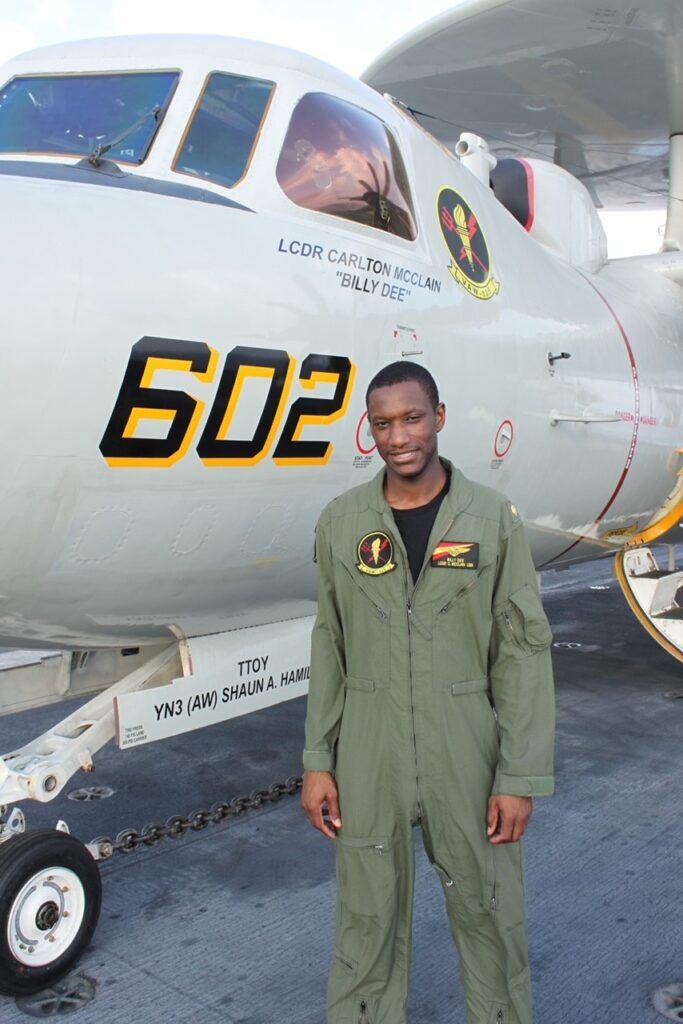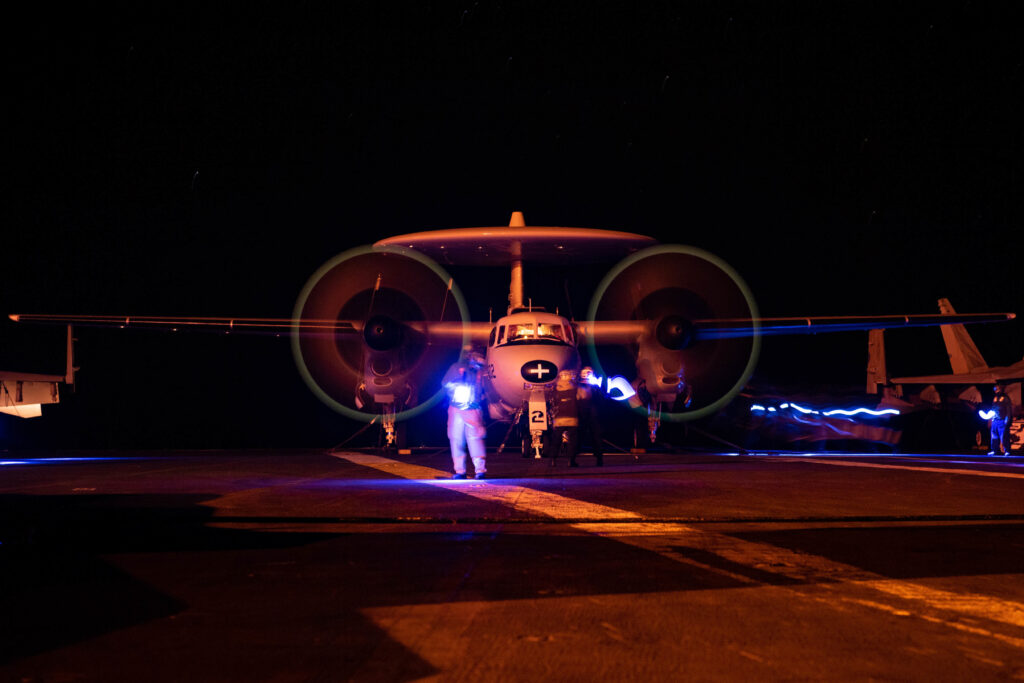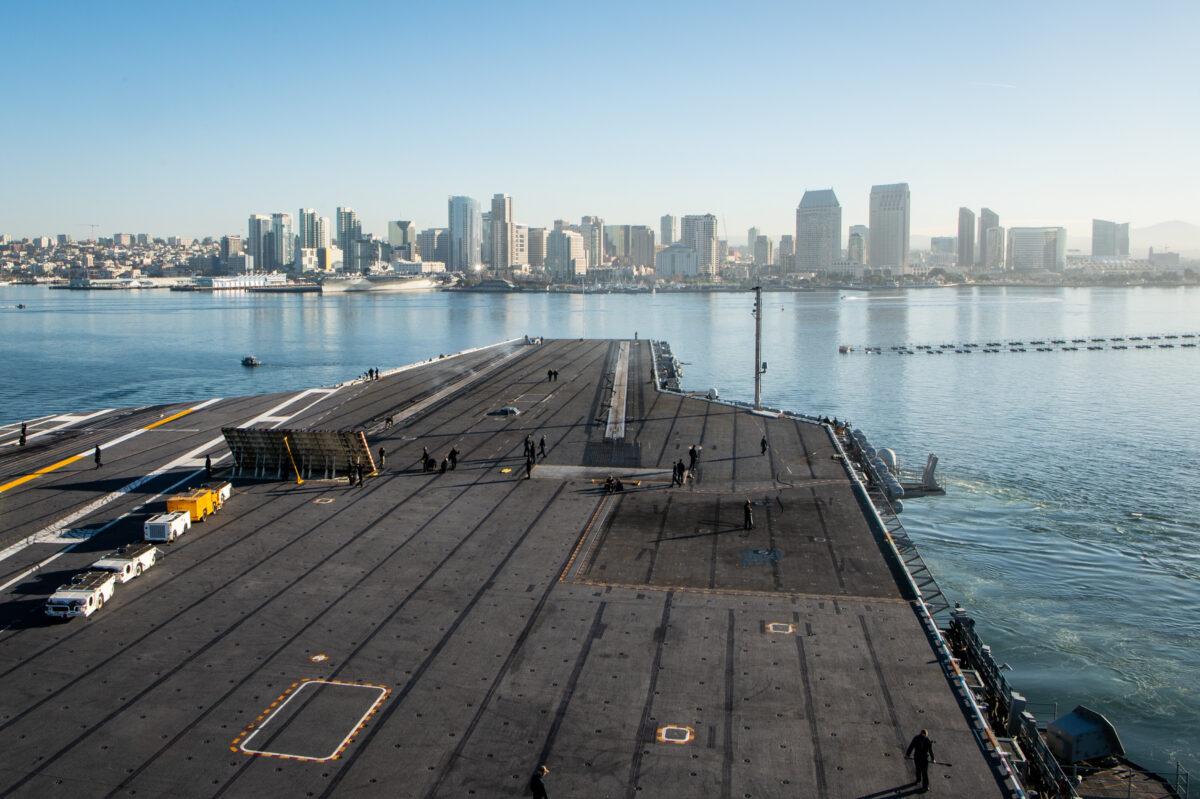In this episode, we’re learning about the biggest ships in the navy: aircraft carriers! Find out what it’s like to live on this gigantic ship and also fly off it at tremendous speed!
Guest bio: Cdr Carlton McClain

Commander Carlton McClain, a native of Florence, SC, graduated and received his commission from the U.S. Naval Academy in 1997 with Bachelor of Science degree in Mechanical Engineering and earned his naval aviation wings in February of 2000.
McClain’s operational assignments were Carrier Airborne Early Warning Squadron (VAW) 123, USS Theodore Roosevelt (CVN71) and USS Enterprise (CVN65); Carrier Airborne Early Warning Squadron (VAW) 125, USS Carl Vinson (CVN70); and served as Assistant Air Officer, USS Abraham Lincoln (CVN72).
McClain’s shore assignments were Pilot NATOPS Officer at Carrier Airborne Early Warning Squadron (VAW) 120, the E-2/C-2 Fleet Replacement Squadron; Carrier Airborne Early Warning Weapons School Operations Officer at the Naval Strike and Air Warfare Center; E-2D Operational Test Director at Air Test and Evaluation Squadron (VX) 1 during Fleet introduction of the E-2D Advanced Hawkeye. He completed an overseas tour as Airspace Manager/Air Defense Officer, Commander U.S. Navy Central Command, 5th Fleet. He currently serves as Officer In Charge, E-2D Fleet introduction Team.
McClain has participated in Operations Enduring Freedom, Iraqi Freedom, Mountain Resolve, Unified Response, New Dawn, and Inherent Resolve. He has accumulated over 4,700 flight hours and 368 carrier arrested landings. His personal decorations include Meritorious Service Medal (2), Air Medal (5), Navy Commendation Medal (3), and various unit and individual awards.
(Commander McClain spoke to us as a private citizen; his views do not necessarily reflect the views of the United States Navy.)
Transcript
Abby: Hey Maggie, what do Abraham Lincoln, John F. Kennedy, Dwight D. Eisenhower and Ronald Reagan have in common?
Maggie: They’re all presidents.
Abby: What if I added George Washington, George H.W. Bush,
Maggie: still presidents …
Abby: and Nimitz and Enterprise?
Maggie: What what? Nimitz and Enterprise aren’t presidents.
Abby: True fact. But they are, along with all those other guys, the topic of today’s episode of
Maggie and Abby: Big If True,
Maggie: where I, Maggie,
Abby: and I, Abby,
Maggie: explore the truth about big things.
Abby: But before we get to the topic of our episode today, did you know that we have an Instagram account, and we do lots of fun things there.
Maggie: In fact, we got a special Instagram Live Event planned for when we hit 500 total downloads, which will be pretty soon.
Abby: So ask your parents to follow us on Instagram at @bigiftruepodcast and get cool bonus stuff. Okay, back to the show. Did you figure out yet what we’re talking about today, Maggie?
Maggie: Nope.
Abby: We’re talking about the biggest ships in the Navy: aircraft carriers.
Maggie: So here’s our quiz question to test your knowledge.
Abby: How long does it take for a plane taking off from an aircraft carrier to get up to 175 knots of speed?
Maggie: A: two seconds, B: five seconds, C: 30 seconds, or D: one minute?
Abby: We’ll tell you the answer near the end of the show.
Maggie: Today we’ve got an expert on him to tell us all about aircraft carriers and how they work.
Carlton McClain: My name is Carlton Josiah McClain. I’m a commander in the United States Navy. And my warfare specialty is naval aviator which means, generally speaking, I fly aircraft. I’m a pilot. I’m from Florence, South Carolina, and I earned my naval commission from the United States Naval Academy. I’ve been in the Navy ever since; I’ve literally never had another job as a grown man than the United States Navy.
Maggie: So as an aviator, you’ve been on aircraft carriers; what carriers have you served on?
McClain: I’ve served on multiple carriers have been attached to the USS Theodore Roosevelt, CVN 71. I’ve been attached to the USS Enterprise, which is CVN 65. I have also been attached to the USS Carl Vinson, that’s CVN 70. And I don’t know maybe my favorite ship I was attached to was the USS Abraham Lincoln. That’s CVN 72.
Maggie: What was your job when you were on those ships?
McClain: It will depend on which time you’re talking about. Because I’m a pilot, my association with the Theodore Roosevelt, the Enterprise, and the Carl Vinson was a part of what is known as the air wing, the Carrier Air Wing. So I flew with the air wing; I flew on and off on all those ships. On the USS Abraham Lincoln, I was actually ship’s company. So I was not a part of the air wing. I was a part of the carrier personnel itself. And my job in that capacity was, I was the assistant air officer, which everyone calls the mini-boss, mini air boss.
Maggie: What a cool name: mini-boss. I would like to be called the mini-boss from now on.
Abby: In your dreams.
Maggie: Okay fine. An aircraft carrier seems absolutely gigantic. So how big is an aircraft carrier?

McClain: It is gigantic, a Nimitz class, which is the class of aircraft carrier which I’ve mostly served on–Enterprise is her own class–the Nimitz class is larger than the Enterprise. And the Nimitz class is over 1000 feet long. So 1092 feet is the length of an aircraft carrier. And I don’t know if you’ve ever seen one, but it’s a really flat and it’s like, it’s like has a big flat top, so it’s kind of longer and wider at the flight deck area. But she actually gets very, very tall, she goes deep into the water, and she weighs a lot. And one of the ways we one of the ways we describe ships is known as displacement. So when a ship goes into the water, it will sink into the water until it has displaced or moved out of the way, as much water as it actually weighs.
Maggie: That’s huge. It must take a lot of people to run a ship that big.
McClain: The ship itself has a complement, that is called ship’s company, that is roughly 2700 personnel. However, when the ship is really really doing its thing, because it’s a floating airport. You need to bring on the aircraft and all of those personnel, that is known as the carrier air wing, and so squadrons that are made up of pilots and made up of what we call maintainers. There are professionals that know how to service and work on aircraft, but they’re also ordinance men. There are also folks that know how to load bombs and and weapons, and administrative support personnel, because people’s pay must be right. They need, there’s all kinds of paperwork that has to be done. So that compliment can really add up to, you know, about 2000 or so people– probably more. And in addition to that their staffs, the admiral’s staff will embark the aircraft carrier, that’s a complement of people, you know. So by the time you’ve piled all these people on when an aircraft carrier is about to deploy, you are looking at probably around 5500 people. When aircraft carrier deploys, there are all kinds of other personnel that are embarked as well, in order for the carrier, and the Carrier Strike Group, which is a group of ships and submarines, to be able to really do what the US Navy does.
Maggie: How many aircraft can an aircraft carrier hold?
McClain: It can hold a lot. During my time in the Navy, like I seen 85 aircraft on an aircraft carrier, I’m pretty sure it was near its max. But it wasn’t the max. Just because it can hold 85 doesn’t mean they will take that many. Now, we generally don’t fly with that number of aircraft anymore. Now it’s more in the 60ish range. But I have heard, you know, the old guys talking about, I’ve heard them say that they’ve had in excess of 90 aircraft on aircraft carrier before. These were, these are older airplanes that we don’t fly anymore. So they could park them a lot closer together because they were made of aluminum. And what if, if you bump them together, the aluminum just bends and you just beat it out until it’s smooth again. The airplanes we have now that are newer, are made of composite and you don’t want them to bump together. So they that’s why they spread them further apart. And that’s why we hope that’s one of the reasons why with less aircraft.
Maggie: What kind of planes do you fly?

McClain: I am NATOPS qualified, which means that that’s my aircraft, in the E-2 Hawkeye, which is the largest aircraft on the aircraft carrier. It is a turboprop with a giant radar dome on the top of it. And because it has such long wings, you really need to be precise in how you land it so you don’t start hitting things with your wings.
Maggie: Aircraft carriers are so huge that it seems like it would be easy to get planes on and off. But when you think about how long runways on the ground, maybe it isn’t so easy.
Abby: Yeah, I don’t think so.
Maggie: How do you launch airplanes off an aircraft carrier?
McClain: You must have a certain amount of airflow over the wings in order for the wings to work. When you go to an airport, or if you’ve been on an airline flight, the plane starts off still. And there, they rev up the engines, you hear everything get kind of loud, and then you’ll start to accelerate down the runway. Well, at some point, once you’re, once things are moving pretty fast out the window, then that plane can rotate and start climbing away from the ground. Then that is what a runway is: it allows the aircraft to have the distance to achieve flying speed so that they can take off. The marvel about an aircraft carrier is you don’t have the room. As big as it is, you don’t have the room to travel that far in order to achieve that speed. And so aircraft carriers, at least fixed wing aircraft carriers, have a catapult. Which their job is to accelerate that aircraft from zero speed to flying speed in a very short period of time. It’s only a few hundred feet, and you will go from zero to 175 knots and under two seconds. It is the baddest, like, rollercoaster ride you will ever have. It is fun, it is exhilarating. And that catapult throws you off of the ship so severely and with such great force, that after the catapult is through with you and has thrown you into the air, the airplane actually slows down. Because the engines can’t produce as much force immediately, instantaneously as the catapult can.
Maggie: Hey, there’s the answer to our quiz question. A plane launching off a carrier goes from zero to 175 knots in just two seconds. But a catapult can’t catch a plane when it lands, right?
McClain: That landing part is very, very critical. You don’t have a runway and you have you don’t have that time to land and then slow down. So they have to slow you down just almost as rapidly as that catapult speeds you up and launches you into into the air. And so what we have is we have a it’s a very kind of a simple kind of a looking system. The aircraft has what is known as a tail hook. So it basically has a hanger hanging down off the back of the aircraft. And in the landing area, there are arresting cables that go across that landing area, that when the plane lands that hanger is supposed to grab that, that wire. Once the hanger grabs the wire, the hanger is attached to the plane, the plane is now attached to the wire, the wire will slow the plane down to a stop. You still need flying speed before you can land. And what an aircraft carrier is going to do is turn into the wind or drive fast enough in the water that she is making that minimum requirement of wind, the plane is going to fly the speed that it needs to fly through the air to stay airborne. However, there are limitations with how fast the closure rate is between the airplane and the ship. And so I don’t want to get like too crazy into physics here. But if the ship was sit, was sitting still in the water, and there was no wind, the airplane will hit the aircraft carrier too fast and too hard for the arresting gear to stop the airplane or for the plane to not break apart. That is the reason why they have minimized that closure rate. And so the ship usually is running along with airplane, although not nearly as fast. But it slows down how, slows down that closure rate. And it slows down how fast that airplane hits the ship. And so that arresting gear won’t take as much beating. And that is how we land aircraft that’s doing 140 knots down to you know a complete and and still so that now that airplane can get out of the landing area and park on the aircraft carrier,
Maggie: Flying a plane from an aircraft carrier sounds rather terrifying. But what’s it like just to be on the carrier itself?
McClain: Most of the time, you don’t know you’re on a ship, because it’s so big and heavy. It’s usually pretty stable in the water. And I’ma tell you as a as a Navy sailor that I’m pretty spoiled by that. Plenty of other, other Navy sailors that are on smaller ships and they they know they’re on a ship, there’s no doubt there’s no forgetting about it. Or submarine, they get moved around pretty good. We also have more room than generally speaking, than sailors on smaller ships, you know, when I say room, I mean in our, where we where we berth, we call it berthing, where we live and where we go to sleep, especially the officers; we have, we have more room than what sailors have on on smaller ships and more supplies, because they have stores, and they always have a– there’s usually a lot of food. We have great ice cream, and others who probably have that too, but because the ship carrier is so big and have bigger freezers and store more stuff, and it’s a, it’s an advantage in some ways. But it’s a, it’s a city. So the other thing is you don’t know everybody on the carrier. And you never will. There’s just so many there’s just too many people.
Maggie: And the carrier carries a lot of stuff, right?
McClain: All those people we talked about, we’re going to put all of their equipment, all their tools, so aircraft tools there are jacks, we’re going to put supplies, so all the food, the cabbage, the beans that everyone needs to eat and drink. Then we actually have a whole bunch of jet fuel that is stored in aircraft carrier so all those aircraft can fly. And and actually, we’ll actually gas some of our small, smaller ships like destroyers and cruisers, because they actually run off jet fuel. And so they’ll pull up alongside aircraft carrier, like a gas station, except that we’re moving through the water at the same time they’re doing this, and pump a bunch of jet fuel over to those to the cruisers and destroyers. So there is a lot of weight that can go into aircraft carrier, and she can actually displace, I don’t know if it’s the max, but I think it’s getting on the top end, 101,000 tons of water is what she can move out the way when she’s really heavy and it really sinks down into the water. So it’s a very, it’s a very, very big ship.
Maggie: Commander McClain, thank you so much for talking to us about aircraft carriers. I learned a lot!
Abby: Me too, and I’m a naval historian. So now, listeners, we want to know which part of being on an aircraft carrier sounds like the most fun to you. Is it being catapulted off the flight deck at tremendous speed, or loading bombs? And just a word too, being in the Navy is for men and women. And flying in the Navy is also for men and women. No matter who you are, you can imagine yourself on an aircraft carrier.
Maggie: And we’ll see you next time for another episode of
Abby and Maggie: Big if True!
Abby: Big If True is produced by me, Abby, and Maggie. Our music is by Andrew Cote. Special thanks this week to Commander Carlton McClain for being our guest. For more about him and other fun resources from the Navy and elsewhere. Check out our show notes at bigiftrue.abbymullen.org. If you liked this episode, please share it with a friend or a family member. And most of all, thanks for listening!
